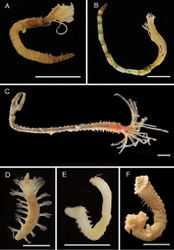Potamethus cf. scotiae
| Notice: | This page is derived from the original publication listed below, whose author(s) should always be credited. Further contributors may edit and improve the content of this page and, consequently, need to be credited as well (see page history). Any assessment of factual correctness requires a careful review of the original article as well as of subsequent contributions.
If you are uncertain whether your planned contribution is correct or not, we suggest that you use the associated discussion page instead of editing the page directly. This page should be cited as follows (rationale):
Citation formats to copy and paste
BibTeX: @article{Gunton2021ZooKeys1020, RIS/ Endnote: TY - JOUR Wikipedia/ Citizendium: <ref name="Gunton2021ZooKeys1020">{{Citation See also the citation download page at the journal. |
Ordo: Phyllodocida
Familia: Sabellidae
Genus: Potamethus
Name
Potamethus scotiae (Pixell, 1913) – Wikispecies link – Pensoft Profile
Diagnosis
Eight thoracic and numerous abdominal segments. Branchial crown with 6–9 pairs radioles. Wide ventral ‘flange’ on ventralmost radioles; ventral sacs large, external to crown; ventral shields present on body. Collar with dorsal lamellae and dorsal pockets, prolonged ventrally with large ventral lappets, oblique laterally. Peristomial ring elongate, exposed above collar. Thoracic notochaetae including superior narrowly-hooded chaetae and two inferior rows of paleate chaetae; thoracic uncini avicular with extremely long handles (> 10 × distance of main fang to breast); companion chaetae present, with similarly long handles. Abdominal neurochaetae of two types: short, broadly-hooded with long tips and longer elongate narrowly-hooded chaetae; abdominal uncini avicular with long handles/shafts, but with breast reduced to narrow swelling at curvature. Ventral surface glandular, thoracic shields prominent. Tubes muddy with fine transverse striations.
Remarks
Four large fragmented specimens were removed from tubes. There are currently no Potamethus species reported from Australia, however, there are museum records of Potamethus collected from deep water east of Tasmania in 1986 (Murray, pers. obs.), and more recently from the GAB surveys in 2015 and 2017 (MacIntosh et al. 2018[1]: additional file 2). Worldwide, there are 11 nominal species, all described from deep waters, and types would need to be examined to determine to which species these specimens belong, or if it is new. Based on descriptions from the literature, the specimens bear greatest resemblance to P. scotiae (Pixell, 1913) from Antarctic waters.
Records
4 specimens. Suppl. material 1: op. 53, 122 (AM).
Taxon Treatment
- Gunton, L; Kupriyanova, E; Alvestad, T; Avery, L; Blake, J; Biriukova, O; Böggemann, M; Borisova, P; Budaeva, N; Burghardt, I; Capa, M; Georgieva, M; Glasby, C; Hsueh, P; Hutchings, P; Jimi, N; Kongsrud, J; Langeneck, J; Meißner, K; Murray, A; Nikolic, M; Paxton, H; Ramos, D; Schulze, A; Sobczyk, R; Watson, C; Wiklund, H; Wilson, R; Zhadan, A; Zhang, J; 2021: Annelids of the eastern Australian abyss collected by the 2017 RV ‘Investigator’ voyage ZooKeys, 1020: 1-198. doi
Images
|
Other References
- ↑ MacIntosh H, Althaus F, Williams A, Tanner J, Alderslade P, Ahyong S, Bax N, Criscione F, Crowther A, Farrelly C, Finn J, Goudie L, Gowlett-Holmes K, Hosie A, Kupriyanova E, Mah C, McCallum A, Merrin K, Miskelly A, Mitchell M, Molodtsova T, Murray A, O’Hara T, O’Loughlin P, Paxton H, Reid A, Sorokin S, Staples D, Walker-Smith G, Whitfield E, Wilson R (2018) Invertebrate diversity in the deep Great Australian Bight (200–5000 m). Marine Biodiversity Records 11(1): e23. https://doi.org/10.1186/s41200-018-0158-x
